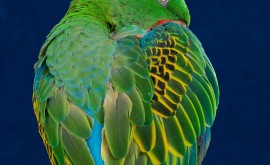In the wild, parrots exhibit four main behaviors: social interaction, grooming, foraging, and sleeping. The vast majority of their days are spent foraging or searching for food. Food is readily available for pet birds. A feeding process that should take hours, may take only minutes in the caged bird. Left with little to fill their days, some birds turn to excessive preening which in turn may lead to feather destructive behavior. Foraging behavior provides pet birds with physical and mental stimulation.
Teaching Companion Parrots to Forage
Foraging appears to be a learned behavior that must be gradually encouraged in our companion parrots. Start slowly. Make food items easy to find at first, and then gradually work towards more complicated and challenging methods.
(1) Multiple Food Stations
- Provide several bowls of food in the cage at various levels. Place a small amount of food in each dish, and ideally place different foods in each dish.
- Try offering food outside of dishes.
- Weave items through cage bars, or wedge chunks between bar spaces. Food should not necessarily be present at each station.
(2) Conceal food items – Once your bird is used to different feeding stations, try hiding food from view.
- Begin by covering food bowls with a piece of paper or cardboard. Initially, poke holes in the cover so your bird sees food is in the dish. Gradually cover the bowl in such a manner that makes it more and more difficult to obtain food. Ultimately secure the cover to the bowl with masking tape.
- Food may also be hidden in crumpled paper cups, twisted corn husks, cardboard paper rolls, PVC piping with holes, and wooden tubes (see the Safe Wood List).
- Wrap food in large lettuce leaves or coffee filters. Slowly make food more difficult to access by twisting or fastening ends together with cotton rope or masking tape. Also, tuck wrapped items between cage bars or hang with clips.
- Commercial puzzle toys such as puzzle boxes, kabob skewers, and piñatas may be found on-line and in pet shops.
- Foraging trees are an excellent way to encourage foraging behavior. Currently not commercially available, foraging trees must be constructed from large tree branches. Secure dishes or platforms at multiple levels. Vary the location of food to encourage true foraging behavior.
(3) Pointers for success
- Start slowly and make food items easy to find at first. Gradually increase the level of difficulty and complexity.
- Allow your bird to see you hiding food to stimulate curiosity and foraging.
- Monitor your birds progress. It may help, especially at first, to demonstrate where food is and how to find it.
- Use your imagination to make foraging fun, but always keep safety in mind. If you are unsure of the safety of an item, consult your avian veterinarian.
- Be persistent! Pet birds often require repeated encouragement until foraging becomes a way of life. In fact, many hand-raised birds, will give up relatively easily when they cannot find food right away.
References
Echols MS. Captive Foraging: The next best thing to being free. Zoological Education
Network, Inc, Lake Worth, FL, USA, 2006.
Echols MS. The behavior of diet. Annu Conf Assoc Avian Vet 2004; 267-270.
Meehan CL, Millam JR, Mench JA. Foraging opportunity and increased physical complexity both prevent and reduce psychogenic feather picking by young Amazon parrots. Appl Anim Behav Sci 2003;80: 71-85.





